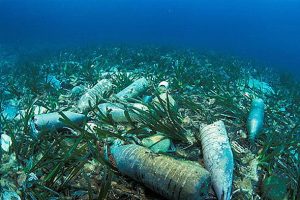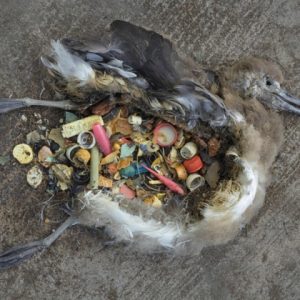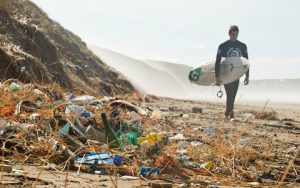
Earth’s largest landfill isn’t on land at all.
Source: Shutterstock
We have a plastic problem! You will find plastic waste in practically every natural environment you visit. Plastic bottles, plastic tops, plastic cups, plastic forks and spoons, plastic bags, plastic balloons, plastic containers – these items litter our ditches, sometimes finding their way into your yard; they are along streambeds that meander through our neighborhoods and parks, they’re floating in our Bay, getting tangled in our marshes, and washing up on just about every beach across our globe because there is an abundance of it in our oceans!
Most have heard the “line the plastic bottles up” analogies, such as “If you were to line up all the plastic bottles found in the ocean, they would reach further than the sun.” These give some idea of the problem, but some of us need numbers not images of dirty bottles reaching the sun, so here you go…
Per TheWorldCounts.com, at least 10% of the 100 million tons of plastic we use every year ends up in the oceans – That is 10 million tons per year! By the way, that is equivalent to the weight of 700 billion plastic bottles going into the ocean EVERY YEAR!
As you can imagine, this continuous flow of plastic waste is finding its way everywhere in our oceans… the waters off our coast, the pristine waters of the Caribbean, the waters that feed the Great Barrier Reef, and even the waters around Antarctica. The plastic waste is getting caught up in our ocean currents and getting pushed around our globe. The currents are also creating another plastic phenomenon, gigantic “plastic soups” or “garbage patches.” There are several of these large bodies of plastic waste. One of these found in the South Pacific spans an area larger than Mexico. The challenge is that these “soups” or “patches” are not necessarily floating bottles and bags, but broken down microplastics, teeny-tiny pieces of plastic waste resembling confetti, that are almost impossible to clean up.

Plastic bottles on the ocean floor. Source: PUNC Bottles

I think we can all agree that this should not be a thing. Source: Tumblr
So What?!
This plastic is killing our wildlife! Animals don’t know to avoid this harmful waste and often mistake it for food. If it does not choke the animal, it fills their stomachs, leaving little to no room to take in the real food they need to live. Sea turtles mistake floating plastic bags and balloons for jellyfish, a common food for sea turtles. Hungry birds see the bright colors and there is no taste or odor to warn them of danger, so they eat it. Some animals, like whales and fish, are ingesting plastic as they open their mouths to eat other things. Whales have been found with stomachs full of plastic bags and fish have tested positive for microplastics in their systems.
I recycle – So I am not the problem, right?
Wrong! The problem is that there is too much plastic being produced. Even if we had the capability to recycle all the different types of plastic produced, it would still not be feasible to do so. It is just way too much! There is still a significant amount going off to a landfill and making its way into our oceans. The best and only thing we can really do to stop this vicious cycle is to stop using it. Let’s each do our part to drastically reduce the amount of plastic used each year from 100 million tons to something more manageable.
Want to see for yourself? Watch this video.

Source: Society of African Missions

Beach Plastic
Source: Telegraph
Christene Mitchell is a Condition Assessment Manager at HRSD, the organization that collects and treats wastewater across Hampton Roads. She is one of the nearly 800 employees that play a part in fulfilling HRSD’s vision that future generations will inherit clean waterways and be able to keep them clean.